Maths Applications of Derivatives
Get insights from 50 questions on Maths Applications of Derivatives, answered by students, alumni, and experts. You may also ask and answer any question you like about Maths Applications of Derivatives
Follow Ask QuestionQuestions
Discussions
Active Users
Followers
New answer posted
a month agoContributor-Level 10

Area of ?
->
->Area (D) = |xy| = |x (– 2x2 + 54x)|
at x = 0 and 18
->at x = 0, minima
and at x = 18 maxima
Area (D) = |18 (– 2 (18)2 + 54 * 18)| = 5832
New answer posted
2 months agoContributor-Level 10
y = x3
Equation of tangent y – t3 = 3t2 (x – t)
Let again meet the curve at
=> t1 = -2t
Required ordinate =
New answer posted
2 months agoContributor-Level 10
Given curves
&
Equation of any tangent to (i) be y = mx +
For common tangent (iii) also should be tangent to (ii) so by condition of common tangency
OR 36m2 + 16 = 31 + 31m2
->m2 = 3
New question posted
2 months agoRelated Tags
Taking an Exam? Selecting a College?
Get authentic answers from experts, students and alumni that you won't find anywhere else
Sign Up on ShikshaOn Shiksha, get access to
- 65k Colleges
- 1.2k Exams
- 679k Reviews
- 1800k Answers


